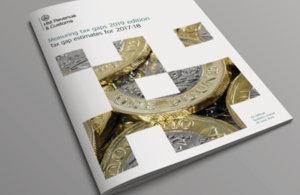Tax gap remains low
The tax gap for 2017 to 2018 is 5.6%, HMRC confirmed today (20 June 2019).

"null"
This means that HMRC collected 94.4% of all the tax due under the law in 2017 to 2018. Overall, the tax gap has fallen from 7.2% since 2005 to 2006.
The tax gap is the difference between the amount of tax that should, in theory, be paid to HMRC, and what is actually paid.
Read the full ‘Measuring tax gaps’ report.
Jesse Norman MP, Financial Secretary to the Treasury, said:
The UK’s low tax gap underlines both how the vast majority of people are paying the correct amount of tax, and how effective HM Revenue and Customs has been in its efforts to clamp down on tax evasion and avoidance.
Key findings from the ‘Measuring tax gaps’ report include:
- our latest tax gap estimates show that 94.4% of all tax due was paid in 2017 to 2018
- the duty-only excise tax gap has reduced from 8.4 % in 2005 to 2006, to 5.1% in 2017 to 2018
- the Corporation Tax gap has reduced from 12.5% in 2005 to 2006, to 8.1% in 2017 to 2018
The majority of customers want to get their tax right, but today’s figures show that too many are still finding this hard, with avoidable mistakes costing the Exchequer over £9.9 billion a year. £3 billion of this is attributable to VAT alone, which underlines the importance of the action HMRC has been taking with Making Tax Digital.
HMRC launched Making Tax Digital in April this year for VAT-registered businesses, with turnover above the VAT threshold, requiring them to keep digital records and submit their VAT return using compatible software. So far, over 400,000 businesses have joined the service.
HMRC expects this service to reduce tax lost due to avoidable errors by ensuring businesses make fewer mistakes, thanks to the improved accuracy that digital records provide and the fact that information is sent directly from those records to HMRC, helping to eliminate transposition errors.
At this year’s level of 5.6%, the tax gap remains low. This is a result of HMRC’s sustained efforts to support the overall health of the tax system, and clearly shows our commitment to getting tax right for everyone.
We have also secured and protected more than £200 billion in extra tax since 2010 that would otherwise have gone unpaid as a result of our actions to tackle tax evasion, tax avoidance, and non-compliance.
In May, the Office for Statistics Regulation reviewed and commended HMRC’s preparation, production and publication of the ‘Measuring tax gaps’ statistics.
It stated:
HMRC is world-leading in measuring tax gaps and is setting the bar for others to follow.
HMRC is continuing to build a healthy tax system by reshaping our organisation around customer needs rather than the individual taxes they pay, and by pursuing our ambition to become one of the world’s most digitally-advanced tax authorities.
Further information
Read the full ‘Measuring tax gaps 2019 edition’ report.
The tax gap has fallen from 7.2% in 2005 to 2006, to 5.6% in 2017 to 2018, with some year-to-year variations.
Since 2010, the government has invested over £2 billion in HMRC to tackle evasion, avoidance and non-compliance and announced over 100 measures to tackle non-compliance in the tax system and aggressive tax planning.
The tax gap methodology has also been intensively reviewed and given a clean bill of health by the International Monetary Fund and scrutinised by the National Audit Office. We are the only revenue authority in the world that measures and publishes the tax gap every year - 2019 marks the tenth year we have published our ‘Measuring tax gaps’ report.